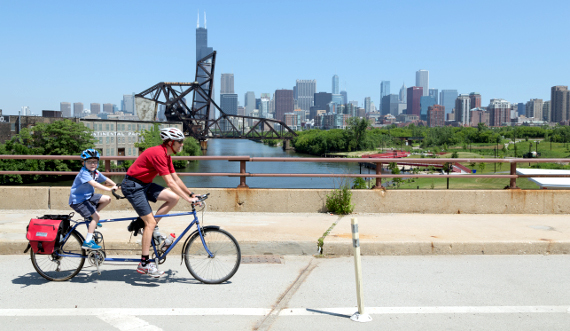
Michael Andersen blogs for The Green Lane Project, a PeopleForBikes program that helps U.S. cities build better bike lanes to create low-stress streets. Second in a series.
The data has been trickling in for years in Powerpoint slides and stray tweets: On one street after another, even in the bike-skeptical United States, adding a physical barrier between bikes and cars leads to a spike in bike traffic.
Now, the first multi-city academic study of U.S. protected bike lanes is out, and a series of anecdotes have formed a very clear trend line: When protected bike lanes are added to a street, bike traffic rises — by an average of 75 percent in their first year alone, for the eight projects studied.
The bike spike showed up at every single facility measured, even those that previously had conventional painted bike lanes.

As pointed out yesterday by CityLab's Eric Jaffe, these rates of growth met or exceeded citywide bike traffic growth in every case. (The one case in which traffic along the lane tracked citywide bike growth, rather than exceeding it, was Milwaukee Avenue in Chicago, a key route into the downtown Loop that was already one of the most-trafficked bike lanes in the country before protection was added.) On average, bike traffic in the protected lanes grew three times faster than bike traffic citywide.
As the new study from Portland State University's National Institute of Transportation and Communities notes, about three-quarters of the new users of these routes tended to come from other routes (presumably because the physical separation makes these safer and more comfortable than the alternatives) and about one-quarter of the new users tend to be using a bicycle when they wouldn't have done so before.
Jennifer Dill, a PSU scholar who co-authored the study, said the evidence is clear that people who bike prefer to do so in these lanes. But it's not clear yet whether these projects will fulfill their true mission: getting a far larger share of Americans to ride bicycles.
"We're seeing people who already bike shifting the routes that they're taking; we're seeing a small amount of new cycling," Dill said. "One thing that we don't know from this or any other research out there is how long it takes for people to really start changing their travel modes."
On that question, it's likely to take a few years for academic evidence to come together. In the meantime, though, it might help to go back to the anecdotes. Washington DC, one of the first U.S. cities to start installing buffered and protected bike lanes -- and also one of the cities that's had the most success at getting its commuters to switch from cars to bicycles -- now has several years of data on two of its routes. They've seen ridership grow much faster than the citywide average, year after year after year:
Will other bikeways around the country see the same ongoing surge in ridership? We'll find out.
You can follow The Green Lane Project on Twitter or Facebook or sign up for its weekly news digest about protected bike lanes.






